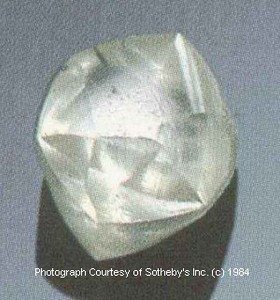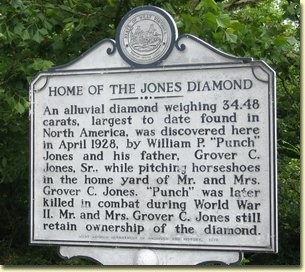Discovery of the Jones Diamond
Introduction
Text-to-speech Audio
In 1928, a rare and unusual discovery was made at this location by a man named William "Punch" Jones. While playing horseshoes with his father, Jones found an interesting shiny pebble in Rich Creek. He kept the diamond for a number of years before a Virginia Tech geologist confirmed the pebble he had found was a 34.46 carat diamond. At the time of discovery it was the only diamond ever discovered in West Virginia, the second largest diamond ever found in the United States, and the largest alluvial diamond ever found in North America. In 1984, Jones' descendants sold the diamond for $67,500.
Images
The Jones Diamond

Historical marker in Peterstown, WV, where the diamond was found.

Backstory and Context
Text-to-speech Audio
In 1928, William "Punch" Jones and his father were pitching horseshoes in their yard in Peterstown, WV, when one of their throws sent a horseshoe into nearby Rich Creek. While retrieving the horseshoe, Jones noticed a shiny, unusual pebble in the creek bed. He took the strange stone and kept it in a cigar box in the tool shed. Ironically, he gave little thought to the stone and over the next few years his large family (Jones had 17 children) struggled during the Great Depression. 14 years after its discovery, Jones took the stone to a Virginia Tech Geologist who confirmed that the strange pebble he found in Rick Creek was one of the finest and largest blue and white alluvial diamond ever discovered.
The Diamond weighed in at 43.46 carats and measured 5/8 an inch in diameter. The gem is the only diamond ever found in West Virginia and the second largest diamond ever found in the United States. The origins of the diamond are unknown. There are no natural sources of diamonds known in West Virginia. However, it is theorized that during the ice age glaciers deposited a few isolated diamonds throughout North America. It is also theorized that the diamond washed down the New River into Rich Creek from a source in Virginia, North Carolina, or Tennessee.
After the stone was identified, the Jones family loaned the diamond to the Smithsonian where it was on display until 1968. After its time in the Smithsonian,the diamond was displayed at the West Virginia State fair. After, the Jones family moved the stone to a safe deposit box where it stayed for 16 years. In 1968, members of the Jones family sold the diamond for $67,500 to a buyer in Asia.
The Diamond weighed in at 43.46 carats and measured 5/8 an inch in diameter. The gem is the only diamond ever found in West Virginia and the second largest diamond ever found in the United States. The origins of the diamond are unknown. There are no natural sources of diamonds known in West Virginia. However, it is theorized that during the ice age glaciers deposited a few isolated diamonds throughout North America. It is also theorized that the diamond washed down the New River into Rich Creek from a source in Virginia, North Carolina, or Tennessee.
After the stone was identified, the Jones family loaned the diamond to the Smithsonian where it was on display until 1968. After its time in the Smithsonian,the diamond was displayed at the West Virginia State fair. After, the Jones family moved the stone to a safe deposit box where it stayed for 16 years. In 1968, members of the Jones family sold the diamond for $67,500 to a buyer in Asia.
Sources
"West Virginia Veterans Memorial - William Pinkney Jones." West Virginia Veterans Memorial - William Pinkney Jones. Accessed March 20, 2015. http://www.wvculture.org/history/wvmemory/vets/joneswilliam/joneswilliam.html.
"Share Jones Diamond." E-WV. Accessed March 20, 2015. http://www.wvencyclopedia.org/articles/1049.
